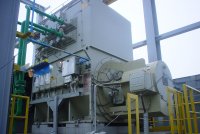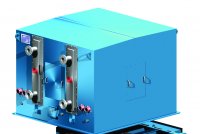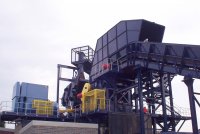In addition to providing high efficiency in applications that require power factor correction, synchronous motors also provide high torques and constant speed under load variation, resulting in low operating and maintenance costs. These benefits explain the use of the motors in the widest range of applications. Typically these include: crushers, mills and conveyor belts in mining and quarry operations; fans pumps and compressors in steel plants; pulp and paper extruders; chippers and de-barkers in wood processing; sewage system pumps; large compressors and fans in chemical and petrochemical applications; mills and crushers in cement works; and water injection pumps on floating oil platforms.
Due to their higher efficiency level, reduced size and higher output rating capacity, synchronous motors can replace DC motors in high performance applications. In addition, in a number of instances, a motor with lower torque values, compared to standard, can actually be applied. This brings a positive reduction in motor starting current, resulting in fewer problems with the electric system during starting, together with a reduction of mechanical stresses from the motor windings.
Synchronous motors have better efficiency and speed accuracy than induction motors; but when compared to the latter, their design is more complex. The simpler design of the induction motor makes them less expensive for a given power level, at power outputs up to 10 megawatts. However, above this figure the higher efficiency of synchronous motors delivers lower operating costs.
The higher efficiency is the result of synchronous motors being superior at converting electrical energy into mechanical power. Moreover, synchronous motors can be designed for high efficiency operation across a broad speed range, providing significant energy saving across a wide variety of loads. In addition, for applications requiring high torque (crushers, extruders, etc), breakdown torque with synchronous motors can be as much as five times higher than the rated torque.
An additional benefit of synchronous motors is their ability to improve stability in VFD applications. Synchronous motors with variable speed are recommended for applications with high torque, low speed and wide speed adjusting range. Depending on load and environment characteristics, motor construction for such applications can be with or without brushes. These motors are suitable to operate at any speed range from zero to maximum speed, maintaining stability independent from load variation, a factor of paramount importance on equipment such as laminators and plastic extruders - et al.
The reductions in day-to-day reduced running costs delivered by synchronous motors are complemented on brushless type machines by reduced maintenance costs. Since the motors are not manufactured with brushes or with slip rings, maintenance, involving inspection and cleaning of these components, is not required.
Synchronous Motors require a DC power supply to power the field winding (rotor winding), which is achieved through a brushless rotating exciter (on brushless versions), or via a static exciter with on motors with brushes. WEG synchronous motors supplied with static exciters are fitted with slip rings and brushes that allow current powering of the rotor poles through slipping contacts. The DC power supply for the poles is derived from an AC/DC converter and static controller. The static exciter is much used on VFD applications.
WEG synchronous motors with brushless excitation system are fitted with a rotating exciter, normally installed on the rear of the motor. Depending on motor operation, the exciter either consists of an exciter with DC power supply on the stator, or one with an AC power supply on the stator.
About WEG Synchronous motors
WEG designs and manufactures synchronous motors in sizes up to 20MW, for general industrial applications, and also versions for hazardous (flammable) atmospheres, both on and offshore. The hazardous area motors are supplied with different protection levels, such as Ex-n (non-sparking) and Ex-p (pressurized), meeting national and international standard requirements, in addition of being tested and approved by worldwide certifying institutions including API, NEMA, IEC, CSA, BVQI, NBR, ABS and DNV.
About WEG
A global major in the power distribution, automation and control sectors, WEG has just celebrated its 50th birthday. The company’s global sales now exceed the US$3-billion mark, representing increasing global success across a wide range of product groups, including the latest generation of transformers, LV control gear, generators, inverter drive systems, soft starters, LV and HV motors, ATEX- compliant explosion proof motors, smoke extraction motors and full turnkey systems. In addition, WEG has recently made a significant strategic expansion of its product portfolio, following the establishment of a joint venture for the manufacturing of wind turbines and the purchase of an Austrian gearbox manufacture, WATT Drive.








